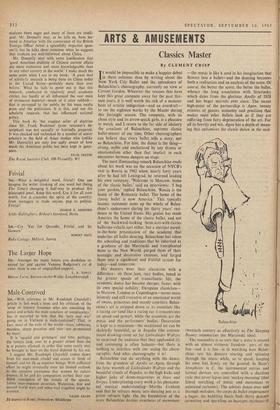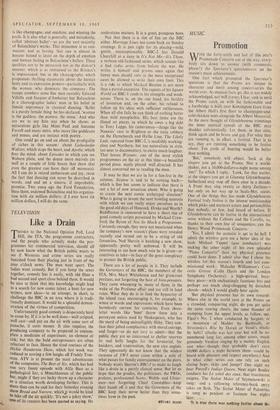ARTS & AMUSEMENTS
Classics Master
By CLEMENT CRISP
IT would be impossible to make a happier debut in these columns than by writing about the New York City Ballet and the splendours of Balanchine's choreography, currently on view at Covent Garden. Whatever the reasons that have kept this great company away for the past thir- teen years, it is well worth the risk of a monster bout of artistic indigestion—and an overdraft— to sec the eighteen works by the Master during this fortnight season. The company, with its clean style and its arrow-quick girls, is a pleasure to watch, and I revere to the far side of idolatry the creations of Balanchine, supreme classic ballet-master of our time. Other choreographers can believe that every ballet tells a story; not so Balanchine. For him, the dance is the thing— strong, noble and uncluttered by any drama or emotionalism other than that implicit in each encounter between dangers on stage.
The most illuminating remark Balanchine made about his work was on the occasion of NYCB's visit to Russia in 1962 when, nearly forty years after he had left Leningrad, he returned leading his own company. 'Welcome to Moscow, home of the classic ballet,' said an interviewer. 'I beg your pardon,' replied Balanchine, 'Russia is the home of the Romantic ballet. The home of the classic ballet is now America.' This typically laconic statement sums up the whole of Balan- chine's endeavours during his thirty years' resi- dence in the United States. His genius has made America the home of the classic ballet, and not of the backward-looking three-acts-with-fairies ballerina-vehicle sort either, but a succinct pared- to-the-bone presentation of the academy that underlies all ballet dancing. Balanchine has taken the schooling and traditions that he inherited as a graduate of the Maryinski and transplanted them to the New World, purged them of their nostalgic and decorative excesses, and forged them into a significant and fruitful system for today—and tomorrow.
His dancers wear their classicism with a difference: on these lean, racy bodies, tuned to the greater speeds of transatlantic life, the
academic dance has become sharper, faster, with its own special nobility; European classicism—
in Moscow, London or Copenhagen—seems more leisurely and still evocative of an emotional world of swans, princesses and moody courtiers. Balan- chine's art is stripped down to its essentials like a racing car (and like a racing car it concentrates on speed,and power), while the essentials are the music and the performers' bodies. Decoration is kept to a minimum—the occasional set can be
skeletally beautiful, as in Bugaku (the conven- tional drawing-room set for Liebeslieder Waltzes
so surprised the audience that they applauded it), and costuming is often hideous—but there is nothing to interfere with our seeing the chore- ography. And what choreography it is!
Balanchine can do anything with the dance, from the grandeur of Apollo or Agon, through the lyric warmth of Liebeslieder Waltzes and the beautiful rituals of Bugaku, to the high kicks and higher jinks of drum-majorettes in Stars and Stripes. Underpinning every work is his phenome-
nal musical understanding—Martha Graham said that he refracts music into dancing just as a
prism refracts light. On the foundation of the score Balanchine devises structures of movement —the music is like b seed in his imagination that flowers into a ballet—and the dancing becomes both a realisation and an analysis of the score. Of course, the better the score, the better the ballet, whence the long association with Stravinsky which dates from the glorious Apollo of 1928 and has begot marvels ever since. The recent high-point of the partnership is Agon, twenty minutes of. genius, economy and precision that makes most other ballets look as if they are suffering from fatty degeneration of the art. For all its brevity and wit, Agon has a depth of mean- ing that epitomises the classic dance in the mid-
Bahmehilre twentieth century as effectively as The Sleeping Beauty summarises the Maryinski ideal.
The musicality is so sure that a score is treated with an almost virtuosic freedom : part of the fun—and it is fun—is in watching how Balan- chine sets his dancers soaring and spinning through the music while, so to speak, keeping his own feet firmly on the ground. In Bizet's Symphony in C, the instrumental entries and formal devices are controlled with a dazzling style that never lapses into cmickey-mousing' (that literal matching of music and movement in animated cartoons). The soloists dance over and through melodies, the corps de ballet impersonate a fugue; the bubbling finale .finds thirty dancer curvetting and sparkling on buoyant rhythms,: ,it is like champagne, and sunshine, and winning the pools. It is also what is generally, and mistakenly, called 'abstract ballet'—as are the vast majority of Balanchine's works. This misnomer is so con- venient, and so boring, that one is almost in honour bound to insist on the depth of emotion and human feeling in Bahinchine's ballets. These qualities are to be perceived not in the dancer's manner, which is as restrained as the Bolshoi's is impassioned, but in the choreography which propounds thrilling statements about the human body and its expressive powers—particularly with the women, who dominate the company. The troupe numbers some fine men (notably Edward Villella and Jacques d'Amboise) but Balanchine is a choreographic ladies man in his belief in female supremacy in classical dancing. 'Ballet is a purely female thing' he has declared, 'woman is the goddess, the poetess, the muse.' And who are we to say him nay when he shows 3s miraculous girls like Mimi. Paul and Suzanne Farrell and many mare, who move like goddesses and muses, and are instinct with poetry.
One could go on and on about the prodigality of riches in this season : about Liebeslieder Waltzes, which stops the heart, and Apollo. which fires the mind, about Episodes in which you see Webern plain, and the dozen more marvels (as well as a couple of little beasts that show that even the greatest can have their off moments). All I can do is record enthusiasm and joy, curse the fact that dancing can never be described in words, and end on a sincere, if improbable, promise. Two years ago the Ford Foundation. bless them, endowed Balanchine and his organisa- tion with six million dollars; if I ever have six million dollars, I will do the same.



































 Previous page
Previous page